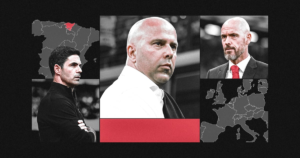The birth of their first child three and a half years ago completed Natalia and Juan Lovato’s lives. Both of ArgentinaJuan was a professional soccer player in Guatemala, where Natalia ran a successful Argentinian restaurant.
However, they soon noticed that their son Ciro could not hold his head. Then they were afraid he wouldn’t make eye contact.
By the time Ciro was one, they found out he suffered from Canavan disease – an extremely rare genetic disorder that causes progressive brain atrophy and eventually leads to death.
“The doctors told us to go home and enjoy being with Ciro because he doesn’t have many years to live,” Natalia said recently.
Still, they weren’t about to give up.
The family heard that a gene therapy trial at a hospital Ohio. When they learned that Ciro would be considered a suitable candidate, the Lovatos sold everything and traveled to Dayton, the western Ohio city of about 136,000 people, in May 2022.
“We didn’t hesitate for a second,” Natalia said.
Canavan disease is caused by mutations in the ASPA gene. It interferes with the body’s production of myelin, the insulating layer around nerve fibers in the brain. Over time, this destroys normal brain development.
Both parents must be carriers of the gene. And there is a one-in-four chance that children of carrier parents will get the disease.
The Genetic and Rare Disease Information Center says Canavan disease affects less than 50,000 children in the US, but experts say the known number of typical cases is likely to be well under a thousand – perhaps as few as 100.
Life expectancy for children with the disease is about 10 years and involves the gradual degeneration of their health, although clinical trials involving gene therapy have proven encouraging. The first person in the world to receive a gene therapy in a trial, in 1996, was Lindsay Karlin, who lived until she was 27 years old.
The single gene therapy what Ciro Lovato and nine other children have received so far in Dayton involves introducing a vector – a virus modified to eliminate its ability to replicate or cause disease – that delivers DNA into the patient’s brain cells .
“The first children we treated were up to five years old, so they had already severely degenerated at that stage. At that stage, there may not even be enough myelin cells to inject and restore function,” said Dr. Robert Lobera pediatric neurosurgeon who led the clinical trials at Dayton Children’s Hospital, the first medical facility to perform intracranial gene therapy using this specific vector for Canavan disease.
“Those kids actually had some improvements in terms of function of their myelin and didn’t have that characteristic decline and degeneration and remained stable.”
Ciro’s parents noticed a marked improvement in his health and well-being.
“Now he can tell us through sounds that he wants us to change the cartoons – he can almost say ‘blue’ when he wants to watch [the Australian animated series] Bluish,” Natalia told.
“If he wants something to eat and we give him an option, he can make noises to tell us which one he wants.”
Lober says that although the gene therapy is experimental rather than a cure or a treatment for the disease, he has seen some families revive.
“It’s more than just gene therapy,” he said. “You give hope.”
to newsletter promotion
But Canavan disease is so rare – it is sometimes called a “orphan disease” – that funding for research and experimentation faces major challenges. One treatment with gene therapy costs about $800,000.
There is also the somewhat selective nature of the trial process which means that not every child with Canavan disease may be able to participate.
“If there’s a child who has brain atrophy, has no basic myelin, has high levels of edema, they’re probably not going to be eligible for a trial because it’s probably not going to work as well,” says Samantha Karlin of the Canavan Research Foundationwhose sister Lindsay was the first to receive gene therapy for Canavan disease.
She said another impediment is that the U.S. Food and Drug Administration has made changes to trial requirements that could cost millions of dollars to implement.
While gene therapy plays an essential role in slowing a child’s degeneration, ongoing physical therapy is crucial.
“I always tell people: getting the gene doesn’t make you myelin. Myelin is activity dependent. You have to go train like a Navy SEAL, you have to go build those roads,” Lober said. “It’s not just about putting the gene in – they have to do those physical therapies.”
That’s exactly where the Lovatos face a new obstacle today.
While the family received help from the Cure Canavan Fundthey were hard at work collect money to pay for a trip to Chicago this month for Ciro’s intensive Dynamic Movement Intervention (DMI) therapy – a technique that helps children with motor delays with posture and balance.
This led to Natalia bowl alfajoresArgentinian cookies that she makes at home and sells online – which sometimes keep her up until 4am.
For now, the Lovatos live hour to hour, day to day.
Sitting in a high chair in a rented apartment outside Dayton, Ciro’s face lit up recently when his mother spread cream cheese on a coconut in front of him. She handed him the snack and, not without effort, Ciro leaned his head back and slowly opened his fingers and released the coconut in his mouth.
A smile spread across his face.





